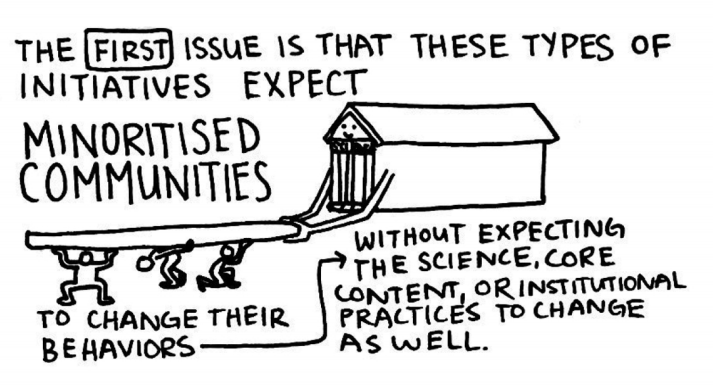
Are you reaching people beyond the typical white middle-class?
Francisco Sanz
March 31, 2020, 3:58 p.m.
After addressing the issue of pollution in our second edition, we chose to focus our third newsletter on another relevant subject for the whole science engagement field and that goes even beyond: Inclusion.
This topic being so broad and diverse, we decided that one article wouldn’t be enough to even start understanding what inclusion actually means and implies. This is why we conducted a series of interviews, to understand how inclusive is the citizen science field at the moment and how this situation could be improved.
We started by contacting Emily Dawson, Associate Professor in the Department of Science and Technology Studies at University College London.
Her research focuses on science engagement with an emphasis on equity and social justice. She recently published the book “Equity, Exclusion and Everyday Science Learning”.
Stay tuned! The next interviews will be shortly published on our website and promoted on our social media channels: Twitter, Facebook and Instagram.
You can also subscribe to our joint newsletter
[Edit] The other interviews are now available: read what Taru Peltola and Shara Fisler shared with us.
Emily, We are curious to hear how your journey in equity and social justice related to science started.
When I started working in science museums, different initiatives were mentioning the notion of “engagement” and “new audiences”. But in reality, everything was centred towards the typical “white, middle/upper class” public. After joining UWE (University of the West of England) in Bristol in 2006, we wanted to make our projects more inclusive, which ended up being harder than we had imagined. At the time, there was no literature or documentation available on this topic, apart from a single 2-page article. As I was frustrated by the lack of information on a subject that seemed so crucial to me, I decided to build the missing pieces of work myself and started a PhD.
For me, doing science communication without being inclusive is pointless. If we do so, we are agreeing to create things for people who already have what they need, and to exacerbating inequalities and the gap between privileged and under-privileged audiences.
How would you define inclusion, and what are the first steps to fight for it/to work towards it?
It seems extremely difficult to find a common definition of inclusion that fits everyone’s idea, and it actually creates several problems.
First, inclusion is nowadays a “hot topic” that is addressed in so many different contexts that it sometimes becomes meaningless. For instance, sadly, sometimes when a project or an organisation is working on a document about inclusion practices, the document itself becomes the intended work rather than the actual progress in the area, as we see in Sara Ahmed’s work. By being superficial, it undermines the whole process.
Then, some people tend to be rather “dogmatic” and only acknowledge their own definition of “inclusion”, and refuse to accept the others. But inclusion and exclusion can take various forms and interpretations, which is why it should always be defined in a specific context and by having a conversation with people experiencing it.
We live in a complex society, where exclusion doesn’t only have one social axis and people can experience more than one type of exclusion, often at the same time. At the moment, I find gender issues are often at the core of every discussion, but that can mean racism is overlooked. But, of course, it doesn’t mean that racism is no longer present. The Black woman who worked with me experienced sexism alongside racism.(and other structural inequalities).
Even though it can be easier for institutions to create inclusive programmes focusing on one problem only, it would be of great value to think more broadly and start with what people actually experience in their everyday life (we could call this an intersectional approach).
For a citizen science project that is only starting to think about being inclusive, could you share some tips or examples of successful initiatives?
Unfortunately, there is no such thing as an “Inclusion top-tips list”, because once again, such a document would be superficial and meaningless in front of the complexity of the issue. With the wide range of activities that can be done in scientific communication, some tips might not work for everything. And even some processes that are very promising, such as co-production, can be useless or harmful if they are poorly executed.
I would say that for every public, respect is the key. Even though building a long-term and trustworthy relationship may seem difficult and time-consuming, it will always be better than short projects that are rarely impactful for people because they are embedded in inequalities.
Try to find people that are interested in working with you, and allow them to build their own role, this could be a more genuinely meaningful experience than drop-in / drop-out.
To me, this is the great potential of citizen science practices. Citizen scientists can be involved from the beginning and throughout the whole process, which has the potential to totally change the relationship between producers and users, and in doing so messes up established power relationships between ‘publics’ and the representatives of ‘science’.
Picture: Issues with projects structured through a crusade logic. From: Equity, Exclusion and Everyday Science Learning – Zine Edition. Book by Emily Dawson / Zine by Sophie Wang